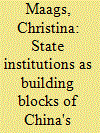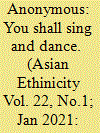| Srl | Item |
| 1 |
ID:
110585


|
|
|
|
|
| Publication |
2011.
|
| Summary/Abstract |
In November 2010, UNESCO included "Acupuncture and moxibustion as part of Chinese traditional medicine" on its Representative List of the Intangible Cultural Heritage of Humanity. Already in 2006, a national list of oral and intangible masterpieces of heritage was drawnup. Nine of them pertained to medicine and traditional pharmacopoeia. Since then, two other national lists have been compiled, containing medical elements. This article analyses the challenges of Chinese medicine's "patrimonialisation" by retracing the discipline's recent as well as much older history. Contents of different lists are examined in this perspective. Chinese medicine finds itself in a paradoxical situation, compared in practical terms with biomedicine, in perpetual reclassification, and held up for good or for bad reasons. Its inclusion in the cultural heritage list highlights many problematic issues, such as master-disciple transmission, vague teaching methods, questions as to the scientific nature or otherwise of its practices, and the industrialisation of its pharmacopoeia. In conclusion, questions may be raised over the link between protection and denaturation throughout the heritage designation process.
|
|
|
|
|
|
|
|
|
|
|
|
|
|
|
|
| 2 |
ID:
192980


|
|
|
|
|
| Summary/Abstract |
The past is continuously reinterpreted to serve the interests of the present. Over the last two centuries of turbulent Chinese history, the past has been redefined through narratives and categorisations. How does the party-state manage the diversity and complexity of China's past, and what implications does this have for state–society relations in China? Based on a case study of China's adoption of the Intangible Cultural Heritage Convention, this article argues that the Chinese party-state creates “infrastructures of memory,” which enable it to actively manage China's diverse past through selective institutionalisation. This process creates a “cognitive map” of tangible and rationalised relations and boundaries between vernacular memories as interpreted by the state. Although this map is to shape and direct Chinese collective memory and identity, it also sparks contestation among members of the populace who seek to preserve vernacular and multiple memories of their socio-cultural past.
|
|
|
|
|
|
|
|
|
|
|
|
|
|
|
|
| 3 |
ID:
177585


|
|
|
|
|
| Summary/Abstract |
This article examines the politics of China’s Intangible Cultural Heritage (ICH) policy and practice in Xinjiang through a study of the profound transformation of three interlinked Uyghur oral traditions ostensibly safeguarded as UNESCO or national-level cultural heritages: muqam, mäshräp and dastan. Based on fieldwork in Xinjiang and among the Uyghur diaspora, it shows how an intensive process of social reengineering, taking place in the nexus of contested state ICH policies and its ‘War on Terror,’ has transformed complex religio-cultural traditions into simplified and exoticized patriotic ‘song and dance’ performances. While the state defines these staged versions as ‘authentic’ heritage that should not be deviated from, community elders and cultural practitioners see them as ‘fake’; they violate community values and disembed fluid oral traditions from everyday life, which is where they are reproduced and generationally transmitted. The rhetoric of ‘safeguarding’ thus represents a disavowal of its actual effects and the severe restrictions on spaces available for cultural practice in Xinjiang.
|
|
|
|
|
|
|
|
|
|
|
|
|
|
|
|